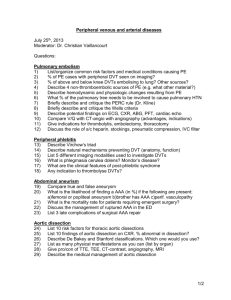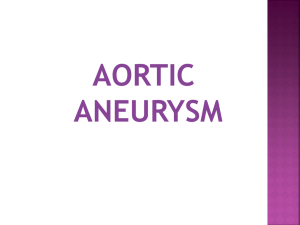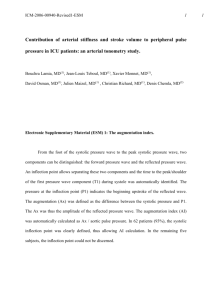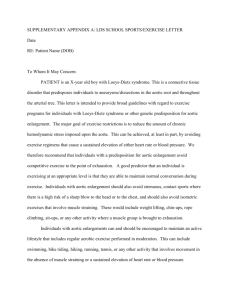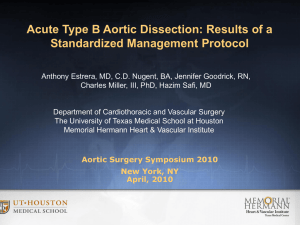Vascular
advertisement
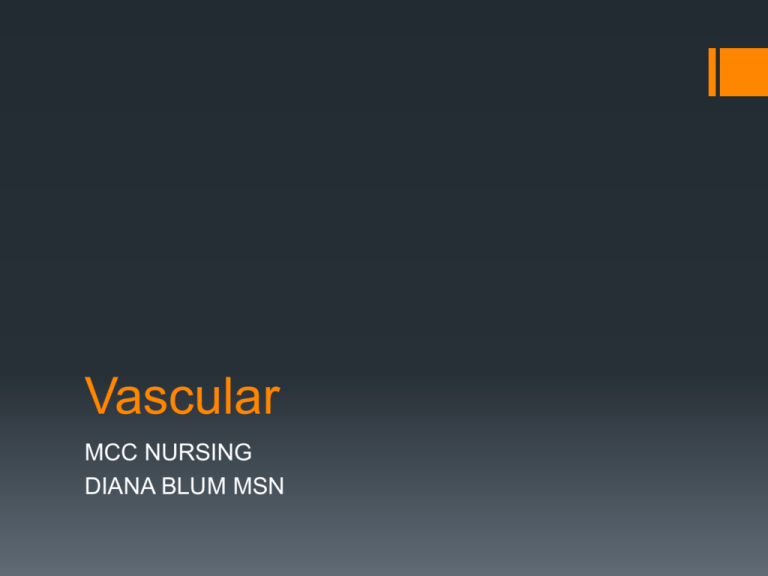
Vascular MCC NURSING DIANA BLUM MSN C reactive protein is a marker for cardiac inflammation Increases mean: risk of damage Homocysteine: protein that promotes coagulation by increasing factor 5 and factor 11 while depressing activation of protein C and increasing thrombus formation risk Vitamin b6 and b12 and folate lowers homocysteine levels hormones Arteriosclerosis (atherosclerosis) Aneurysm formation Arteriosclerosis obliterans Raynaud’s phenomenon Arterial embolism Thromboangiitis obliterans Diabetic arteriosclerotic disease hypertension Arterial diseases: 3 Manifestations :ARTERIAL (50% occulsion before symptoms) Prolonged capillary refill: - 3 seconds or more Ulcers: - open lesions on feet from diminished distal perfusion Ischemia (reduced oxygenation) - leads to pain Paresthesia (decreased sensation in extremities = tingling/numbing) Pain (in feet/leg muscles = burning, throbbing, cramping) -usually from exercise BUT also with elevation of lower extremities 4 -describes arterial disorders in which degenerative changes result in decreased blood flow Atherosclerosis: - most common form of arteriosclerosis, excessive accumulation of lipids Arteriosclerosis 5 Most common affected areas from arteriosclerosis: Heart: coronary arteries (angina, MI, death) Brain (transient ischemic attacks =TIAs CVA, death) Kidneys (renal arterial stenosis lead to chronic renal failure) Extremities (gangrene of digits & intermittent claudication) 6 -inflammatory process, begins as fatty streaks that are deposited in the intima of the arterial wall Genetics and environment play a factor in the progression Elastic arteries: aorta, carotid, lg & med. sized muscular arteries (popliteals) most susceptible arteries. Endothelial injury: may be initiated by smoking, hypertension, diabetes, hyperlipidemia, Pathophysiology of atherosclerosis 7 Inflammatory cells(including macrophages) become attracted to the wall Macrophages infiltrate wall and ingest lipid which turns them into foam cells They then release biochemical substances that cause further damage and attract platelets which then causes clots to form Ankle-brachial index of blood pressure: Used to diagnose peripheral vascular disease -compares the blood pressure at ankle with that of the arm. -normally these should be the same (with a ratio of 1) -lesser number than 1 shows decreased blood pressure at the ankle compared to upper extremity = = which indicates peripheral vascular disease to lower extremities 9 10 Indications for fem-pop bypass: diabetes hypertension vasculitis collagen disease Bueger’s disease Also, Embolectomy (surgical removal) SURGERY 11 Fem-pop bypass 12 MEDICAL MANAGEMENT ANTIPLATELET THERAPY Aspirin, ticlid, plavix, pletal, trental Beta blockers ARBs Statins Radiation therapy Angioplasty with stents Nursing Interventions Monitor BP for difference between arms Could be indicative of aortic coarctation Narrowing of aorta lumen Monitor for carotid bruits Assess cap refill, pulses,skin Acute arterial stenosis Monitor for the 5 P’s pain, sudden pallor pulselessness paresthesias paralysis 15 Acute peripheral arterial occlusion may result from rupture and thrombosis of an atherosclerotic plaque, an embolus from the heart or thoracic or abdominal aorta, an aortic dissection, or acute compartment syndrome Symptoms and signs are sudden 17 Buerger Disease Autoimmune disease Recurrent inflammation of small arteries and veins of the extremities resulting in thrombus formation and occlusion. Unknown cause Men 20-35 years old All races Link to heavy smoking/chewing tobacco s/s: rubor (reddish blue) color to foot, no Pedal pulse, discolored legs when dangled, eventually gangrene sets in Enlargement of artery to @ least 2X its normal Aortic dissection Medial & intimal layers separate Risk Factors: -hypertension -cocaine use - Marfan syndrome Aneurysms of Central Arteries 19 Aortic Dissections: Type III most common type 20 Abdominal Aortic Aneurysm Size and Rupture Risk* AAA Diameter (cm) Rupture Risk (%/yr) <4 0 4–4.9 1% 5–5.9* 5–10% 6–6.9 10–20% 7–7.9 20–40% >8 30–50% *Elective surgical repair should be considered for aneurysms > 5.0–5.5 cm. Aortic dissection 22 n/v, diaphoresis with pain “tearing” pain Sudden onset not relieved with change of position Dissection of ascending aorta: anterior CP with radiation to neck, throat, jaw Dissection of descending: interscapular back pain radiation to lower back or abdomen Signs/symptoms of aortic dissection: 23 Treatment of hypertension for aortic dissection: IV propranolol Nitropresside drip after beta blocker ( nitropresside by itself causes tachycardia AND left vent. contractility that is why a beta-blocker should be given first, then start nitropresside drip) Diagnosis: CXR (but 10% normal) see medialstinal widening Contrast CT MRI 24 Surgery for distal dissections: Mortality in 1st 48 hrs if unrepaired proximal aortic dissections is 40% Usually distal dissections treated medically unless: rapid expansion saccular formation persistent pain hemodynamic compromised blood leakage impending rupture 25 26 Dacron tube 27 Abdominal Aortic Aneurysm (AAA) 75% of all aneurysms Located between renal arteries & aortic bifurcation Symptoms from pressure exerted in surrounding structures. Many nonsymtomatic until ruptures Look for pulsating abdominal mass With rupture: hypovolemic shock & mortality around 90% 28 Post-op nursing interventions for graft: Vitals Pulses distal to graft Report: changes in pulse cool extremities distal to graft white/blue to extremities distal to graft severe pain abd. distention decreased UO 29 Post-op nursing intervention (continued) Post graft Elevation of head to 45° or less Renal function lab Respiratory status Paralytic ileus (NG tube) Assess for dysrhythmias post thoracic 30 Skin color changes: reddened or cyanotic Edema: pooling of fluid results in edema Venous stasis ulcers: skin breakdown due to increased pressure from chronic pooling of blood Decreased mobility: may result from the edema Pain: - in feet/ leg muscles; aching/throbbing - results from venous stasis & increases as day progresses (esp with sitting or standing) Temperature changes: - warm to touch since blood can enter but cannot leave affected parts Venous manifestations: 31 DVT : Groin tenderness/pain Unilateral sudden onset edema leg Homan’s sign (appears in only 10% of pt with DVT) Ultrasonography 32 Rest (do NOT massage area) Low-molecular weight heparin Coumadin TPA ****Contraindications to anticoagulant therapy Pt compliance, bleeding, aneurysms, trauma, alcohol, recent surgery, liver or kidney disease, hazard jobs, pregnancy DVT interventions: 33 Monitor for hemorrhage Monitor PT/PTT Heparin is therapeutic b/w 60-92 on ptt Coumadin is therapeutic b/w 2-3 on PT/INR Monitor for Thrombocytopenia Monitor Platelets s/s; purpura, bruising, hematomas Provide bedrest Ted Hose or ace wraps for prevention of DVT SCDs for prevention of DVT Pain meds Nursing cares - excessive tension exerted on arterial walls which places pts at increased risk for target organ damage -asymptomatic until complications develop - elevation may be systolic or diastolic or both - normal <120 mmHg systolic <80 mmHg diastolic Hypertension 35 Pathophysiologic processes for hypertension: BP=CO X peripheral resistance Elevated BP is direct result of increased peripheral resistance, increased CO or both Renin-angiotensin-aldosterone system Aldosterone: increased water/Na+ retention thus increasing ECF volume which leads to increased CO with subsequent increase BP 36 Possible Causes of PVR Narrowing of blood vessels, PVD, CAD, kidney disease: > renin/angiotensin =vasoconstriction Release of catecholamine (epinephrine and adrenalin) = vasoconstriction > blood volume= more work to pump > Blood viscosity=harder to pump Ability of blood vessel to stretch 37 Large vessels: aneurysmal dilation accelerated atherosclerosis aortic dissection Cardiac: acute= pulm edema, MI chronic= LVH Cerebrovascular: acute= Intracranial bleed, coma, seizure mental status changes, TIA, stroke chronic=TIA, stroke Target Organ Disease from hypertension 38 Renal: acute=hematuria, azotemia chronic=elevated creatinine proteinuria Retinopathy: acute=papilledema, hemorrhages chronic=hemorrhages,exudates, Target organ disease from hypertension: 39 Treatment of hypertension: Lifestyle modification ABCD: ACE inhibitors; ARB B-blockers Calcium channel blockers Diuretics 40 Hypertensive Crisis: Treatment Parenteral agents for immediate redux of BP In ICU for monitoring Arterial line Drug of choice: sodium nitroprusside =direct acting arterial & venous vasodilator = reduces BP rapidly but lower mean arterial pressure no more than 25% over 1st 2 hours = easily titratable = monitor closely for hypotension = shield this drip from light 41 STROKE: occlusion of cerebral vasculature DUE TO: 1. emboli that lodges in cerebral vasculature (from a-fib, vegetations on an infect valve) 2. atherosclerotic plaque (occludes carotid arteries) 3. venous occlusion (secondary to thrombosis) 4. arterial dissection (in carotid or vertebrobasilar system) 5. severe hypotension ( infarct in cerebral areas) 6. hemorrhage :occurs during activity 42 Sudden loss of function resulting from disrupted blood supply to area in brain 5 types: Large artery Caused by atherosclerosis Small penetrating artery Most common Also called lacunar strokes because it creates a cavity Cardiogenic emboli Usually from afib Cryptogenic No known cause Other Caused from Drug use, migraines,spontaneous TIA Hemorrhagic stroke Bleeding into brain tissue or ventricles, subdural, or subarachnoid spaces due to ruptured aneurysm or from severe hypertension VASOSPASM (after a bleed) 4-14 days post hemorrhage Management is difficult 45 Prevention Manage HTN Avoid alcohol Increase public awareness Assessment Tools Neurological assessment upon admission or change in client status, including: Level of consciousness Orientation Motor ability Pupils Speech/language Vital signs Blood glucose Treatment for stroke: (Note similar to measures for myocardial ischemia/MI) Thrombolysis (who is not a candidate?) Lower BP Quit smoking Decrease cholesterol Antiplatelet (ASA) 49 Stroke treatment (continued) ASA Heparin (SQ or IV contin infusion) Low-molecular wt heparin (lovenox) Warfarin (coumadin) ------------------------------------------------------Obtain PT, PTT prior to therapy PT: monitor oral anticoag : goal=1.5 to 2 times pt baseline PTT: monitor heparin: goal=1.5 to 2 times pt baseline INR: monitor Warfarin: goal=2 to 3 50 More stroke treatment: Carotid artery angioplasty Arteriovenous Malformation (gamma radiation through Gamma knife) Aneurysms (coils) Craniotomy for clot removal 51 Impaired physical mobility: -flaccid, spasticity Disturbed sensory perception: -vision, proprioception, sensation Unilateral neglect: - use both sides of body (dress affected side first) Impaired verbal communication:: -expressive, receptive, both Impaired swallowing: must be evaluated, must prevent aspiration !!! But yet meet caloric needs Urinary and/or bowel incontinence Nursing Diagnosis 52 Complications Rebleed Vasospasm Hydrocephalus Hypoxia of brain Nursing interventions Administer oxygen Provide adequate hydration Evaluate swallow function Frequent neuro checks Strict I/O Seizure precautions Monitor ICP Monitor BP closely Teach stress reduction techniques Manage agitation Evacuation of blood via craniotomy Goal of surgery is to prevent further rupture/bleed Post op complications Disoriented Amnesia Korsaff’s syndrome (psychosis caused by lack of thiamine) Personality changes Intraop emboli Electrolyte disturbances GI bleed Surgery and complications QUESTIONS???
